
One of our goals with the Metrology Matters newsletter is to share our insights and knowledge about what we see going on in our shared economy and specifically the sectors we do business with the most. Interestingly, due to the size of these industries — the markets we are most active in like aerospace, automotive, and medical device are so large they affect almost everybody.
This month we’re going to shed some light on the U.S. aerospace and defense industries specifically. Aerospace is the largest net exporter in the manufacturing industry, with a $70 billion surplus in 2012 according to a U.S. Department of Commerce,SelectUSA report.
What companies make up the aerospace & defense market sector?
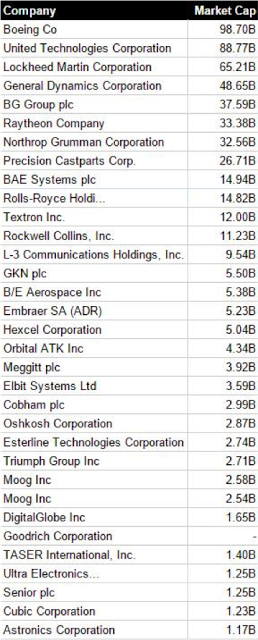
In the table on the right, I have included companies in the aerospace/and defense market sector sorted by market capitalization. Most of the information that will be presented will be in relation to one or more of these companies.
How well is the aerospace and defense market doing in 2015?
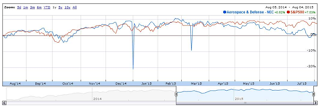
The above chart from Google Finance shows the performance of the aerospace and defense market sector over the last year. The data Google pulled from NYSE shows us the sector has fallen overall since the end of May after following the S&P 500 for nearly a year.
What does the future hold for the Aerospace sector?
The FAA produced an aerospace forecast for 2014-2034.
It’s quite a long and extensive report and at first glance the forecast already seems a bit skewed even by 2015. The report goes over the many risks and assumptions that must be taken into account with a long term forecast like this — which are numerous and unpredictable — including things like terrorist attacks, fuel prices, the overall world economy and wildcards of new innovative fuels and even the viability of commercial space travel.

Chart from the FAA Forecast
But, if it is an important sector for you or your company there is a lot of valuable data in it, all the way through to the appendices, which include alternative models for the forecast. Overall, it’s a very good place to start.
3 Major Developments affecting U.S. Aerospace and Defense
#1) Long Range Strike Bomber / Next Generation Bomber / 2018 Bomber
We won’t try to cover everything here, but we’re going to at least touch on the highlights since the contract is expected to be awarded this year to either Northrop Grumman or a Boeing and Lockheed Martin team.
Here are excerpts from two Wikipedia articles on the project. You can find the original links and links to two other articles on the project below.
The following was excerpted from Wikipedia Articles (edited for length and clarity):
Design
The design goals in January 2011 were:[27]
● Total program cost estimated at $40 to $50 billion.[27]
● Fleet size of 175 aircraft: 120 for ten combat squadrons, plus 55 for training and reserves.[27]
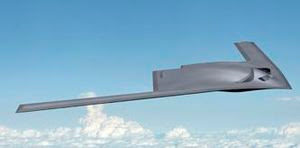
● Subsonic maximum speed.
● Range: 5,000+ nautical miles (9,260+ km).[27]
● “Optionally manned” (for non-nuclear missions).[27]
● Total mission durations of 50 to 100 hours (when unmanned).[27]
● Ability to “survive daylight raids in heavily defended enemy territory[28]
● Ability to carry thermonuclear weapons.[27]
● Designed to use commercial off-the-shelf propulsion, C4ISTAR, and radar technologies.[29]
● Intelligence, surveillance, target acquisition, and aerial reconnaissance along with command and control gear to enable the crew to direct other aircraft and forces.[30]
Competitive phase
The U.S. Air Force released its request for proposals to industry for the (Long-Range Strategic Bomber) LRS-B on 9 July 2014. Because the RFP is in the competitive phase of acquisition, few details will be made public until the contract is awarded in the second quarter of 2015. What is known is that the platform must be based upon mature technology and adaptable for large payloads.
The LRS-B is expected to replace the B-52 fleet, possibly replace a portion of the B-1 fleet, and be complemented by the B-2 fleet. Northrop Grumman could base their efforts in Florida if they won the contract, which would provide tax credits, while California passed a bill offering tax credits to the manufacturer if they build it in their state, which would mainly benefit the Lockheed-Boeing team.[55][56] On August 14th last year, the California legislature passed a measure to apply tax benefits equally to prime contractors and subcontractors. The previous measure only applied to “subcontractors”, meaning Lockheed, as part of the Lockheed-Boeing team, would be allowed to use their facility in Palmdale, California. This had left Northrop Grumman at a near half-billion-dollar disadvantage in the bidding. The new measure levels the tax benefit field by also applying them to prime contractors, as Northrop Grumman has no subcontractor and also has operations in Palmdale.[57]
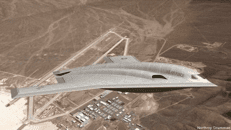
As of January 2015, the only unclassified information on the proposed LRS-B is that production is targeted at 80–100 aircraft, it will replace the B-52 and B-1 bomber fleets, it will be stealthy, mature technologies will be used rather than launching new developments (although it will have an open architecture for future features), and initial operational capability is planned for the mid-2020s with certification to carry nuclear weapons approved two years later; optional manning is still being discussed. With a target price of $550 million per aircraft, Defense News quoted a source with knowledge of the program predicting that the LRS-B may be smaller than the B-2, perhaps half the size, powered by two engines in the Pratt & Whitney F135 power class.[58]
One of the main effects of the program will be its impact on the industrial base, as three of the country’s five largest defense firms are competing. After the LRS-B, the Air Force will not have another large attack aircraft program until the 2030s for a new fighter, with a follow-on bomber after that. With that stretch of time in between, the loser may be put out of the military attack airframe industry entirely; Northrop Grumman would likely not retain the infrastructure required for the next program 15 years later, and Boeing’s main aircraft field is now based on its commercial products. Industrial impact may cause any contract to be contested by Congress from representatives that receive campaign donations from a company whose award would create jobs for constituents. In addition to competing with other Air Force priorities, budgets may put the LRS-B at odds with other services’ priorities like the Ohio Replacement Submarine.[58]
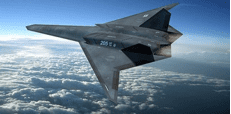
In April 2015, Pentagon undersecretary for acquisition Frank Kendall revealed that individual technologies for the LRS-B will be competed as well to enhance flexibility and drive down costs. This means even though one team will build the aircraft, other competitors will have the chance to compete for sustainment and upgrade features.[59] Although a contract was to be awarded in early summer 2015, it was pushed back to September 2015 to sure up requirements. Prolonging this part of the process is seen as a time and money-saver later in the acquisition to ensure the resulting bomber can be useful over a 50-year lifespan.[60]
Additional Recent Information Sources:
From April BreakingDefense.com website:
Tough Choices For DoD On Long Range Strike Bomber
From June 26th on CNBC.com:
Defense Contractors compete for huge bomber contract
2) What’s the future hold for Rolls Royce?
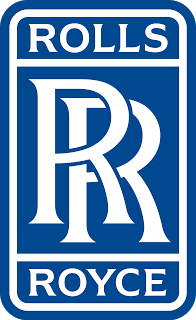
Aerospace-Rolls-Royce-Logo-fr:Wikimedia.Commons
Having moved into the top 10 worldwide for the first time according to the 2014 Price Water House Cooper report – Top 100 Aerospace Companies, they’re doing pretty well. As the #2 civil aero engine supplier they’re also in good shape from the investment side according to a Greenwood Investors report from July 31st.
Excerpt from Greenwood Investors Report:
In A Nutshell:
“As a new CEO with a great track record just assumed the cockpit and predictably lowered near-term expectations, Rolls Royce represents a very compelling investment, particularly for a new CEO that can craft a new flight path for restoring the company’s competitiveness back to a level compatible with its perceived brand awareness. The aerospace division of Rolls, which represents roughly two thirds of its revenue, is significantly under-earning its main competitor, GE Aviation, by over half. Rolls Royce’s strategy of using outsourced third parties for 75% of the value of the jet engine has put the company at a significant disadvantage versus its American competitor. Yet, we view this entire margin gap as a very fixable situation.”
Typical of high-level finance and investment reporting there is an opposing point of view that says almost the opposite about the new CEO and Rolls’ stability into the 2020s in a July 11th article from The Economist, Hitting Turbulence.
In both cases though, the reports tout Rolls’ strengths in civil jet engine manufacture and the current forecast for increases in airline travel and lower oil prices being good news for the aerospace sector suppliers and manufacturers.
Additional Resource:
SlideShare from 2014 Aerospace Top 100 Special Report-PwC
3) General Electric forecast strong demand for engines

At #7 in the PwC report of the Top 100 Aerospace companies, Ohio’s GE Aviation, just finished attending the International Paris Airshow in July and is reported to have racked up another $10 billion in jet engine orders. Not bad for a week’s work.
From a recent article in the Dayton Daily News:
“GE Aviation expects to grow its backlog of jet engine orders to more than $150 billion at this week’s International Paris Air Show, President and Chief Executive Officer David Joyce told international media Monday at a company briefing during the event. Before the show started, the order book for jet engines and services from GE and its joint ventures stood at $140 billion, with more than 15,000 engine orders to fill. It’s a record high for the Ohio manufacturer.”
Source :Dayton Daily News – Strong demand for new and existing engines boost GE Aviation sales
What impact does aerospace and defense have on your business?
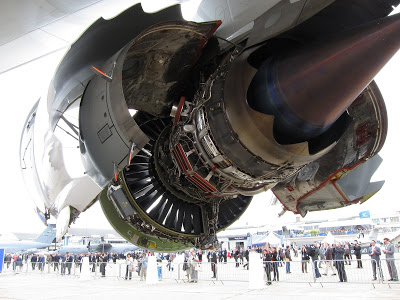
As we mentioned at the outset, the sheer size of aerospace and defense means their impact on 1000s of companies and 100s of thousands of jobs is absolutely vital to the entire manufacturing industry.
With Boeing firmly at the top for almost two decades looking at what is happening in the rest of the sector shows that despite Western nation’s cuts on defense, according to the Price Water House Cooper report the future has never been so bright.
What does all this have to do with Wenzel America?
Interestingly, we have two technologies, the COREand our LH with REVO that could not be more fitted to quality inspection of the turbine blades used by all these companies and their suppliers.
Briefly, the CORE coupled with OpenDMIS gives a unique ability to measure blades always “in plane” and the throughput for measurements is faster than the fastest tactile scanning. As for the REVO blade, manufacturers get the fastest tactile scanning available with an infinite positioning articulating head speeding inspection and reducing CMM tooling costs. REVO can even be fitted on the largest CMMs, including Wenzel LH Gantry CMMs.
We just published an in-depth article on CORE vs. LH with REVO on the blog. CORE and REVO were also big players in our recent Metrology Matters Live Open House, and are featured in our 7-Systems Analysis Whitepaper.
